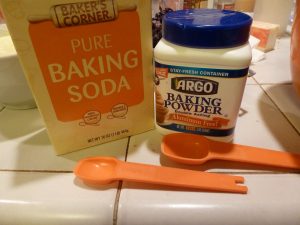6 Chapter 6-Types of chemical leaveners
Learning Objectives
Types of chemical leaveners 
- Baking Soda
- Baking Powder
Baking Soda-also known as sodium bicarbonate or bicarbonate of soda
- In the presence of moisture and acidity baking soda starts to decompose into carbon dioxide and other gases.
- This means it has a low bench tolerance (how long a batter can stay mixed, but not baked).
- Items with baking soda should be mixed and baked immediately, or leavening power is lost since the soda reacts immediately upon contact with moisture and acidity.
- A high amount of baking soda is needed when used alone as the only source of leavening.
- Be careful, as too much baking soda in a product can result in a yellow or green discoloration and a strong chemical flavor.
- Baking soda is used with one or more acids. This allows the baking soda to break down more quickly and therefore, less is needed.
- Common acidic ingredients in the bakeshop including buttermilk, sour cream, yogurt, fruit/fruit juices, molasses, honey, vinegar, brown sugar, unsweetened chocolate, and natural cocoa powder.
Baking Powder-composed of baking soda + an acid + a dry starch (filler)
- All baking powders release the same minimum amount of carbon dioxide
- All baking powder is double-acting which means it needs both moisture and heat to complete its activation.
- If you ever come across the term “single-acting baking powder”, it means that the baking powder immediately reacts with water lowering bench tolerance.
- This type of baking powder is not very common but was used in early baking history.
- Double-acting baking powder has a relatively high bench tolerance since it requires both moisture and heat.
Check out this video that goes over the differences between Baking Powder and Baking Soda!

